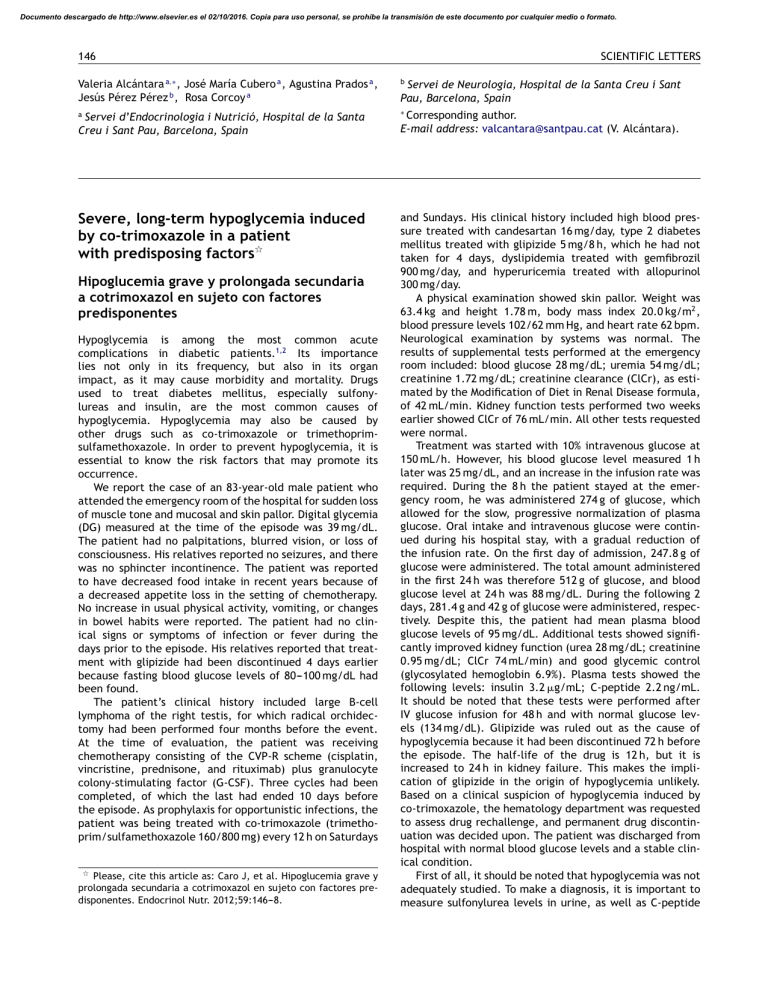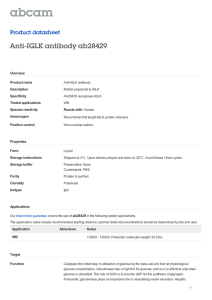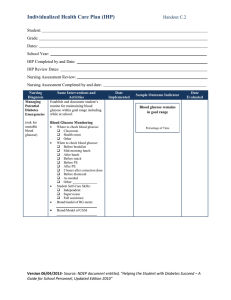Severe, long-term hypoglycemia induced by co
advertisement

Documento descargado de http://www.elsevier.es el 02/10/2016. Copia para uso personal, se prohíbe la transmisión de este documento por cualquier medio o formato. 146 SCIENTIFIC LETTERS Valeria Alcántara a,∗ , José María Cubero a , Agustina Prados a , Jesús Pérez Pérez b , Rosa Corcoy a b Servei de Neurologia, Hospital de la Santa Creu i Sant Pau, Barcelona, Spain a Servei d’Endocrinologia i Nutrició, Hospital de la Santa Creu i Sant Pau, Barcelona, Spain ∗ Corresponding author. E-mail address: valcantara@santpau.cat (V. Alcántara). Severe, long-term hypoglycemia induced by co-trimoxazole in a patient with predisposing factors夽 and Sundays. His clinical history included high blood pressure treated with candesartan 16 mg/day, type 2 diabetes mellitus treated with glipizide 5 mg/8 h, which he had not taken for 4 days, dyslipidemia treated with gemfibrozil 900 mg/day, and hyperuricemia treated with allopurinol 300 mg/day. A physical examination showed skin pallor. Weight was 63.4 kg and height 1.78 m, body mass index 20.0 kg/m2 , blood pressure levels 102/62 mm Hg, and heart rate 62 bpm. Neurological examination by systems was normal. The results of supplemental tests performed at the emergency room included: blood glucose 28 mg/dL; uremia 54 mg/dL; creatinine 1.72 mg/dL; creatinine clearance (ClCr), as estimated by the Modification of Diet in Renal Disease formula, of 42 mL/min. Kidney function tests performed two weeks earlier showed ClCr of 76 mL/min. All other tests requested were normal. Treatment was started with 10% intravenous glucose at 150 mL/h. However, his blood glucose level measured 1 h later was 25 mg/dL, and an increase in the infusion rate was required. During the 8 h the patient stayed at the emergency room, he was administered 274 g of glucose, which allowed for the slow, progressive normalization of plasma glucose. Oral intake and intravenous glucose were continued during his hospital stay, with a gradual reduction of the infusion rate. On the first day of admission, 247.8 g of glucose were administered. The total amount administered in the first 24 h was therefore 512 g of glucose, and blood glucose level at 24 h was 88 mg/dL. During the following 2 days, 281.4 g and 42 g of glucose were administered, respectively. Despite this, the patient had mean plasma blood glucose levels of 95 mg/dL. Additional tests showed significantly improved kidney function (urea 28 mg/dL; creatinine 0.95 mg/dL; ClCr 74 mL/min) and good glycemic control (glycosylated hemoglobin 6.9%). Plasma tests showed the following levels: insulin 3.2 g/mL; C-peptide 2.2 ng/mL. It should be noted that these tests were performed after IV glucose infusion for 48 h and with normal glucose levels (134 mg/dL). Glipizide was ruled out as the cause of hypoglycemia because it had been discontinued 72 h before the episode. The half-life of the drug is 12 h, but it is increased to 24 h in kidney failure. This makes the implication of glipizide in the origin of hypoglycemia unlikely. Based on a clinical suspicion of hypoglycemia induced by co-trimoxazole, the hematology department was requested to assess drug rechallenge, and permanent drug discontinuation was decided upon. The patient was discharged from hospital with normal blood glucose levels and a stable clinical condition. First of all, it should be noted that hypoglycemia was not adequately studied. To make a diagnosis, it is important to measure sulfonylurea levels in urine, as well as C-peptide Hipoglucemia grave y prolongada secundaria a cotrimoxazol en sujeto con factores predisponentes Hypoglycemia is among the most common acute complications in diabetic patients.1,2 Its importance lies not only in its frequency, but also in its organ impact, as it may cause morbidity and mortality. Drugs used to treat diabetes mellitus, especially sulfonylureas and insulin, are the most common causes of hypoglycemia. Hypoglycemia may also be caused by other drugs such as co-trimoxazole or trimethoprimsulfamethoxazole. In order to prevent hypoglycemia, it is essential to know the risk factors that may promote its occurrence. We report the case of an 83-year-old male patient who attended the emergency room of the hospital for sudden loss of muscle tone and mucosal and skin pallor. Digital glycemia (DG) measured at the time of the episode was 39 mg/dL. The patient had no palpitations, blurred vision, or loss of consciousness. His relatives reported no seizures, and there was no sphincter incontinence. The patient was reported to have decreased food intake in recent years because of a decreased appetite loss in the setting of chemotherapy. No increase in usual physical activity, vomiting, or changes in bowel habits were reported. The patient had no clinical signs or symptoms of infection or fever during the days prior to the episode. His relatives reported that treatment with glipizide had been discontinued 4 days earlier because fasting blood glucose levels of 80---100 mg/dL had been found. The patient’s clinical history included large B-cell lymphoma of the right testis, for which radical orchidectomy had been performed four months before the event. At the time of evaluation, the patient was receiving chemotherapy consisting of the CVP-R scheme (cisplatin, vincristine, prednisone, and rituximab) plus granulocyte colony-stimulating factor (G-CSF). Three cycles had been completed, of which the last had ended 10 days before the episode. As prophylaxis for opportunistic infections, the patient was being treated with co-trimoxazole (trimethoprim/sulfamethoxazole 160/800 mg) every 12 h on Saturdays 夽 Please, cite this article as: Caro J, et al. Hipoglucemia grave y prolongada secundaria a cotrimoxazol en sujeto con factores predisponentes. Endocrinol Nutr. 2012;59:146---8. Documento descargado de http://www.elsevier.es el 02/10/2016. Copia para uso personal, se prohíbe la transmisión de este documento por cualquier medio o formato. SCIENTIFIC LETTERS and insulin in plasma at the time of hypoglycemia. Both measurements were not adequately made, which makes final diagnosis difficult. There are however adequate data to establish that co-trimoxazole triggered hypoglycemia. The patient suffered severe hypoglycemia (28 mg/dL). This decreased plasma blood glucose level occurred in the setting of transient renal failure; ClCr at the emergency room was 42 mL/min, as compared to a prior clearance of 76 mL/min. It was also difficult to achieve adequate blood glucose levels in the first few hours despite the administration of intravenous glucose at high doses (512 g in the first 24 h). The discontinuation of glipizide 72 h before the episode rules out this drug as a potential cause of hypoglycemia because its half-life, even in renal failure, is shorter than 72 h. Finally, the plasma insulin levels of the patient were normal in the presence of normal blood glucose and high-dose intravenous glucose infusion. All of these data represent a clinical presentation that supports this diagnosis. As already stated, drugs are the most important cause of hypoglycemia. The most important drugs inducing hypoglycemia are those used to treat diabetes mellitus,3,4 but there are up to 164 drugs related to this event. According to a review by Cryer et al.,2 these drugs are classified into three groups: moderate, low, and very low level of evidence. Co-trimoxazole is included in the last group. Co-trimoxazole is a combination of two antimicrobial drugs, trimethoprim and sulfamethoxazole, which act synergistically.5,6 The most important study of its hypoglycemic effect is a review of 14 cases where hypoglycemia caused by co-trimoxazole was found.7 This study supports our diagnosis because it reported initial characteristics similar to those of the case discussed here. Aggravating factors for the development of hypoglycemia were first analyzed. Renal function worsening concomitant with the start of hypoglycemia was found in 93% of cases. Our patient had a ClCr of 42 mL/min, as compared to 73 mL/min at baseline. Another related factor was the presence of an additional hypoglycemic drug (43%). As regards to cotrimoxazole dosage, double the standard doses were used in up to 50% of reported cases. The mean blood glucose level measured in recruited patients was 25 mg/dL, with a range of 18---33 mg/dL. The reported patient also had severe hypoglycemia, with a blood glucose level of 28 mg/dL. Hyperinsulinemia was found in 88% of the patients tested (7 out of 8), while high C-peptide levels were found in all 5 patients tested. All the patients reviewed had clinical signs. More than one-third of the patients experienced neuroglycopenic symptoms such as seizures, confusion, or loss of consciousness. Our reported patient also had glycopenic clinical signs. The course of these patients is also noteworthy. They all required intravenous glucose infusion, but almost half of them (43%) had blood glucose levels in the lower limit of normal despite high-dose glucose infusion (>25 g glucose/h). This also occurred in our reported patient, who required high doses of intravenous glucose (>500 g glucose during the first 24 h). Despite this, blood glucose normalization was difficult. Finally, most subjects (86%) included in the review were discontinued treatment with co-trimoxazole to prevent new episodes of hypoglycemia.8,9 Hughes et al.10 reported a patient with acquired immunodeficiency syndrome who started treatment with co- 147 trimoxazole and levofloxacin 500 mg for pneumonitis. Six days later, the patient experienced severe hypoglycemia requiring high doses of intravenous glucose for normalization. High insulin and C-peptide levels were found (30.2 mU/L and 4.2 nmol/L respectively). Shattner et al.11 reported a 34-year-old male patient, also with AIDS, who experienced hypoglycemia induced by co-trimoxazole in the setting of severe malnutrition. The mechanism of action by which co-trimoxazole is assumed to cause hypoglycemia is as follows. Cotrimoxazole belongs to the sulfonamide class and is therefore biochemically similar to sulfonylureas. The increase of insulin secretion through its binding to beta cell receptors seems the most reasonable mechanism of action. However, hypoglycemia does not occur in the absence of other promoting factors. Kidney function impairment is the most significant triggering factor because it increases drug half-life. The use of greater than standard doses also aggravates the described mechanism. This would result in an increased stimulation of pancreatic beta cells, and thus in higher plasma insulin levels. Nutritional patient status (often impaired in patients with acquired immunodeficiency syndrome and elderly and cancer patients) is another determinant factor in the occurrence of hypoglycemia. If the concomitant use of another glucose-lowering drug is added to these conditions, high insulin release will occur and will lead to severe and prolonged hypoglycemia. Conflicts of interest The authors state that they have no conflicts of interest. References 1. Cryer PE. Hypoglycemia, functional brain failure, and brain death. J Clin Invest. 2007;117:868. 2. Cryer PE, Axelrod L, Grossman AB, Heller SR, Montori VM, Seaquist ER, et al. Evaluation. Management of adult hypoglycemic disorders: an Endocrine Society Clinical Practice Guideline. J Clin Endocr Metab. 2009;94:709--28. 3. Szoke E, Gosmanov NR, Sinkin JC, Nihalani A, Fender AB, Cryer PE, et al. Effects of glimepiride and glyburide on glucose counterregulation and recovery from hypoglycemia. Metabolism. 2006;55:78---83. 4. Zammitt NN, Frier BM. Hypoglycemia in type 2 diabetes: pathophysiology, frequency, and effects of different treatment modalities. Diabetes Care. 2005;28:2948---61. 5. Gleckman R, Blagg N, Joubert DW. Trimethoprim: mechanisms of action, antimicrobial activity, bacterial resistance, pharmacokinetics, adverse reactions, and therapeutic indications. Pharmacotherapy. 1981;1:14. 6. Paap CM, Nahata MC. Clinical use of trimethoprim/sulfamethoxazole during renal dysfunction. DICP. 1989;23:646---54. 7. Strevel EL, Kuper A, Gold WL. Severe and protracted hypoglycaemia associated with co-trimoxazole use. Lancet Infect Dis. 2006;6:178---82. 8. Portesky L, Moses AC. Hypoglycemia associated with trimethoprim/sulfamethoxazole therapy. Diabetes Care. 1984;7: 508---9. Documento descargado de http://www.elsevier.es el 02/10/2016. Copia para uso personal, se prohíbe la transmisión de este documento por cualquier medio o formato. 148 9. Arem R, Garber AJ, Field JB. Sulfonamide-induced hypoglycemia in chronic renal failure. Arch Intern Med. 1983;143:827---9. 10. Hughes CA, Chik CL, Taylor GD. Cotrimoxazole-induced hypoglycemia in an HIV-infected patient. Can J Infect Dis. 2001;12:314---6. 11. Shattner A, Rimon E, Green L, Coslovsky R, Bentwich Z. Hypoglycaemia induced by co-trimoxazole in AIDS. BMJ. 1988;297: 740. Late diagnosis of an index case of SDH-related paraganglioma/ pheochromocytoma syndrome夽 Diagnóstico tardío de un caso índice de síndrome paraganglioma/feocromocitoma asociado a la SDH Paragangliomas (PGLs) are uncommon neuroendocrine tumors (prevalence, 1/1700) derived from neural crest cell lines and occurring in adrenal medulla (pheochromocytoma [PHEO]), chemoreceptors, and sympathetic and parasympathetic ganglia.1 Clinical signs and symptoms depend on location, secretory profile, and malignant potential. Approximately 25% of PHEOs and PGLs are familial in origin and are part of different syndromes such as von Hippel-Lindau (VHL), multiple endocrine neoplasia type 2 (MEN2), neurofibromatosis type 1 (NF1), and the PGL/PHEO syndrome due to germline mutations in succinyl dehydrogenase enzyme (SDH),2 a enzyme involved in electron transfer and Krebs cycle and expressing a wide phenotypic heterogeneity.3 We report the case of a patient with paraganglioma/pheochromocytoma syndrome diagnosed 25 years after the occurrence of the first signs of the disease. A 65-year-old male was admitted for constipation and abdominal pain over the previous 15 days and reported constitutional symptoms for 6 months. An endoscopy showed a stenosing mass in the rectosigmoid junction which required the placement of a Wallflex stent. Biopsy could not be performed. Patient clinical history included type 2 diabetes mellitus, high blood pressure, and chronic obstructive pulmonary disease (COPD). He had been diagnosed in 1985 with bilateral carotid paragangliomas, treated by surgical resection, and a right tympanic paraganglioma. During the course of the disease, the patient had experienced two relapses that had been treated with radiotherapy and tomoradiosurgery. The father of the patient had died of cervical tumors, and his 30-year-old daughter had been diagnosed with a tympanic paraganglioma at 15 years of age and, more recently, with a carotid paraganglioma. 夽 Please, cite this article as: Sánchez-Pacheco Tardón M, et al. Diagnóstico tardío de un caso índice de síndrome paraganglioma/feocromocitoma asociado a la SDH. Endocrinol Nutr. 2012;59:148---50. SCIENTIFIC LETTERS Juan Caro ∗ , Inmaculada Navarro-Hidalgo, Miguel Civera, José T. Real, Juan F. Ascaso Servicio de Endocrinología y Nutrición, Hospital Clínico Universitario de Valencia, Departamento de Medicina, Universitat de Valencia, Valencia, Spain ∗ Corresponding author. E-mail address: juancaro84@gmail.com (J. Caro). Laboratory test results included a blood glucose level of 169 mg/dL and a carcinoembryonic antigen (CEA) level of 10.7 ng/mL (0---5 ng/mL). A CT scan of the abdomen and pelvis revealed a 4.3-cm necrotic mass in the interaortocaval retroperitoneum, a 2.6-cm left adrenal mass, a 1.5-cm right adrenal mass, and a mass in the rectosigmoid junction. The patient reported headache, sweating, palpitations, tremor, and nervousness virtually daily over a period of several years, which had been attributed to an anxietydepression syndrome and for which he was receiving long-term treatment with lorazepam. He was found to have an impaired general condition, dysphagia, right recurrent nerve palsy, a weight of 58 kg, and BP levels of 105/58 mmHg. The patient subsequently experienced paroxysmal hypertension. No striae, neurofibroma, Cushingoid habitus, cafe au lait spots, or Lisch nodules were found. Based on his family history, head and neck paragangliomas, clinical signs and the symptoms of the patient, and new radiographic findings, the first diagnostic possibility considered was that the adrenal tumors were bilateral functioning pheochromocytoma and that the retroperitoneal tumor was a new abdominal paraganglioma, thus encompassing the whole clinical tumoral spectrum within the same condition, an SDH-related paraganglioma/pheochromocytoma syndrome. The stenosing rectosigmoid neoplasm could also have been an intestinal stromal tumor (GIST), which is associated with such a syndrome, although tumor location was more consistent with an intestinal adenocarcinoma. Based on this, measurements were made of fractionated catecholamines and metanephrines in 24-h urine (epinephrine <10 g/24 h Figure 1 MIBG scintigraphy: uptake by both adrenal glands and retroperitoneal mass.


